Getting pet odor out of furniture can be a challenge, but with the right strategies, you can maintain a fresh and inviting home. PETS.EDU.VN offers effective and practical solutions for removing lingering pet odors from your beloved furniture. Discover how to neutralize odors, clean effectively, and keep your living space smelling pleasant with pet odor removal, odor neutralizers, and fabric refreshers.
1. Identifying the Source of Pet Odor
The first step in eliminating pet odor is to identify its source. This involves a thorough investigation to pinpoint where the smell is most concentrated. Knowing the source helps you target your cleaning efforts more effectively.
1.1. Locating the Odor Hotspots
Start by sniffing around your furniture, particularly areas where your pet spends the most time. Common hotspots include:
- Favorite Resting Spots: Pets often have preferred spots on the couch, chairs, or beds.
- Accident Areas: Accidents happen, and these spots can be a significant source of lingering odors.
- Areas Near Food or Water: Spills and crumbs can attract bacteria and contribute to unpleasant smells.
1.2. Inspecting for Stains and Spills
A visual inspection is crucial. Look for:
- Visible Stains: Urine, saliva, or vomit stains are obvious culprits.
- Hidden Spills: Use a blacklight to detect urine stains that may not be visible under normal lighting.
- Areas with Discoloration: Discoloration can indicate old stains or areas where moisture has been trapped.
1.3. Assessing Fabric Type and Material
The type of fabric or material of your furniture will influence the cleaning methods you can use. Consider the following:
| Fabric Type | Cleaning Considerations |
|---|---|
| Microfiber | Generally easy to clean; can use water-based cleaners. |
| Leather | Requires special leather cleaners; avoid harsh chemicals that can damage the material. |
| Upholstery (Cotton) | Can be more absorbent; may require deeper cleaning methods. |
| Delicate Fabrics (Silk, Linen) | Requires gentle cleaning solutions and methods to avoid damage. Consider professional cleaning. |
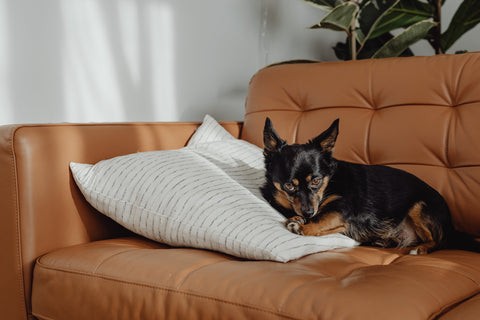
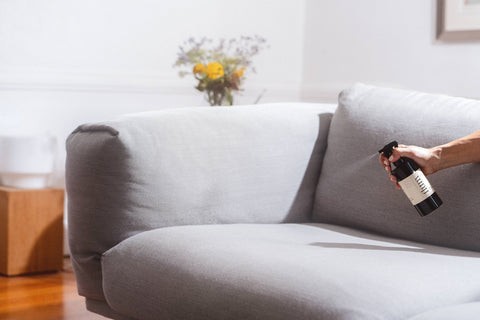
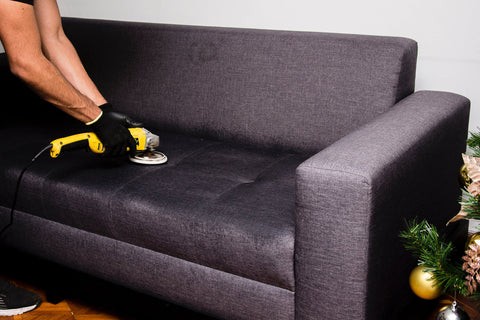
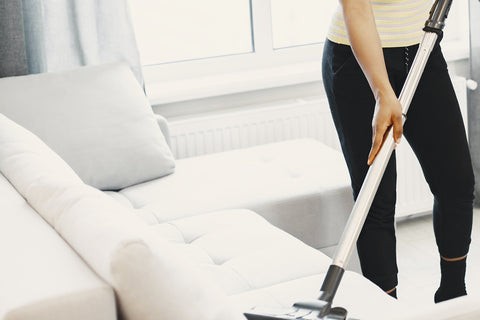
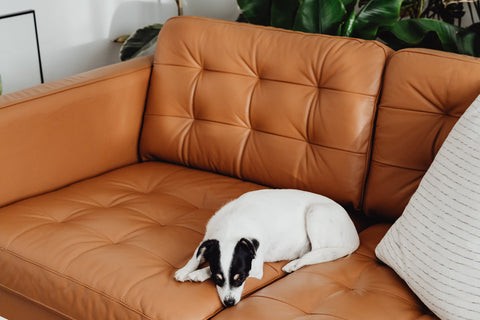
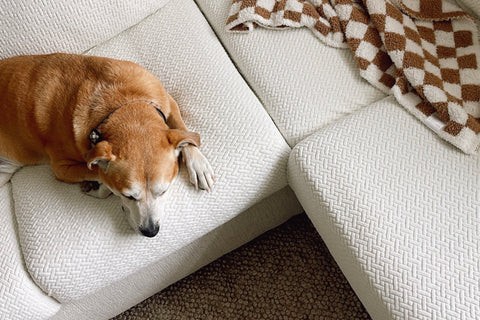
Knowing your fabric type will help you choose the most appropriate and effective cleaning solutions.
2. Natural Cleaning Solutions for Pet Odor Removal
For those who prefer a more natural approach, several household items can effectively neutralize pet odors. These solutions are often safer for pets and children and are environmentally friendly.
2.1. Baking Soda: The Ultimate Odor Absorber
Baking soda is a powerhouse when it comes to odor absorption. Its alkaline properties help neutralize acidic odors, making it an ideal choice for tackling pet smells.
-
How to Use:
- Sprinkle a generous amount of baking soda over the affected area.
- Rub it gently into the fabric.
- Let it sit for several hours, or ideally overnight.
- Vacuum thoroughly to remove the baking soda.
-
Pro Tip: For stubborn odors, mix baking soda with a few drops of essential oil (pet-friendly, of course) before sprinkling it on the furniture.
2.2. Vinegar Solution: Neutralizing and Disinfecting
White vinegar is another excellent natural cleaner and deodorizer. Its acidity helps break down and neutralize odors, while its disinfecting properties can help eliminate bacteria.
-
How to Use:
- Mix equal parts of white vinegar and water in a spray bottle.
- Lightly mist the solution over the affected area.
- Allow it to air dry completely.
- If the vinegar smell lingers, ventilate the room well.
-
Caution: Always test the solution on a small, inconspicuous area of the furniture first to ensure it doesn’t cause discoloration or damage.
2.3. Essential Oils: Adding a Fresh Scent
Essential oils can be a great addition to your cleaning routine, providing a pleasant and natural scent while also offering some antimicrobial benefits.
-
Pet-Safe Options:
- Lavender
- Chamomile
- Cedarwood
- Eucalyptus (use sparingly and ensure proper ventilation)
-
How to Use:
- Add a few drops of your chosen essential oil to your baking soda or vinegar solution.
- Always dilute essential oils properly to avoid irritation to pets.
- Avoid using oils that are toxic to pets, such as tea tree oil, peppermint, and citrus oils.
| Essential Oil | Benefits | Safety Considerations |
|---|---|---|
| Lavender | Calming and relaxing; can help reduce anxiety in pets. | Generally safe for pets when diluted and used in moderation. |
| Chamomile | Anti-inflammatory and soothing; can help with skin irritations. | Ensure it is Roman chamomile, as other varieties may not be safe. |
| Cedarwood | Natural insect repellent; can help deter fleas and moths. | Use sparingly, as high concentrations can be irritating. |
| Eucalyptus | Decongestant and antiseptic; can help with respiratory issues. | Use sparingly and ensure proper ventilation; toxic in high concentrations. |
3. Commercial Cleaners: Effective Solutions for Stubborn Odors
When natural solutions aren’t enough, commercial cleaners designed specifically for pet odors can provide a more potent solution. These products often contain enzymes that break down the organic compounds causing the odor.
3.1. Choosing Pet-Friendly Cleaners
Always opt for cleaners that are labeled as pet-friendly. These products are formulated to be safe for use around animals, minimizing the risk of irritation or toxicity.
- Look for labels that indicate:
- Non-toxic
- Enzyme-based
- Safe for pets and children
3.2. Applying Commercial Cleaners
Follow the instructions on the product label carefully. Generally, you’ll want to:
- Test the cleaner on a small, inconspicuous area first.
- Apply the cleaner to the affected area, ensuring it penetrates the fabric.
- Allow it to sit for the recommended time.
- Blot the area with a clean cloth to remove excess cleaner.
- Allow the furniture to air dry completely.
3.3. Avoiding Harsh Chemicals
Be cautious of cleaners that contain harsh chemicals, such as bleach or ammonia. These can be harmful to pets and can also damage furniture.
- Chemicals to Avoid:
- Bleach
- Ammonia
- Formaldehyde
- Phthalates
| Cleaner Type | Benefits | Cautions |
|---|---|---|
| Enzyme Cleaners | Breaks down organic compounds; effective for urine, feces, and vomit. | May require longer contact time; follow instructions carefully. |
| Odor Neutralizers | Masks or eliminates odors without necessarily cleaning the source. | May not be effective for deeply embedded odors; choose pet-friendly options. |
| Fabric Refreshers | Provides a temporary fresh scent; good for regular maintenance. | May contain allergens; avoid spraying directly on pets. |
4. Deep Cleaning Techniques for Embedded Pet Odors
For odors that have deeply penetrated the furniture, deep cleaning techniques are necessary. These methods go beyond surface cleaning to remove the source of the odor.
4.1. Pre-Clean Vacuuming: Preparing for Deep Cleaning
Before you start any deep cleaning, thoroughly vacuum the furniture to remove pet hair, dander, and other debris. This step is crucial for allowing the cleaning solution to reach the source of the odor.
- Vacuuming Tips:
- Use a vacuum with a HEPA filter to trap allergens and fine particles.
- Use the upholstery attachment to reach crevices and corners.
- Vacuum in multiple directions to lift embedded hair and debris.
4.2. Steam Cleaning: A Thorough Solution
Steam cleaning is an effective way to remove deeply embedded odors and stains. The hot steam penetrates the fabric, lifting dirt and grime to the surface.
-
Steam Cleaning Steps:
- Fill the steam cleaner with water and add a pet-friendly cleaning solution if desired.
- Test the steam cleaner on a small, inconspicuous area first.
- Move the steam cleaner slowly over the furniture, overlapping each pass.
- Allow the furniture to air dry completely.
-
Important Considerations:
- Check the manufacturer’s instructions for your furniture to ensure it is safe for steam cleaning.
- Avoid over-wetting the fabric, as this can lead to mold growth.
- Ventilate the room well during and after steam cleaning to speed up the drying process.
4.3. Post-Cleaning Airing: Eliminating Lingering Odors
After deep cleaning, it’s essential to air out the furniture to eliminate any lingering odors and ensure it dries completely.
- Airing Tips:
- Open windows and doors to create cross-ventilation.
- Use fans to circulate air around the furniture.
- Place the furniture in a sunny spot to help dry it faster.
| Cleaning Method | Suitable For | Steps |
|---|---|---|
| Vacuuming | Removing pet hair, dander, and surface debris. | Use HEPA filter, upholstery attachment; vacuum in multiple directions. |
| Steam Cleaning | Deeply embedded odors and stains; durable fabrics. | Test first; move slowly, overlapping passes; avoid over-wetting; ventilate well. |
| Airing Out | Eliminating lingering odors and ensuring complete drying after cleaning. | Open windows and doors; use fans; place furniture in a sunny spot. |
5. Preventative Measures and Regular Maintenance
Preventing pet odors from embedding in your furniture is easier than removing them. Regular maintenance and proactive measures can keep your furniture smelling fresh.
5.1. Regular Pet Grooming: Reducing Hair and Dander
Grooming your pet regularly helps reduce the amount of hair and dander they shed, minimizing the buildup of odor-causing substances on your furniture.
- Grooming Tips:
- Brush your pet daily to remove loose hair.
- Bathe your pet regularly with a pet-friendly shampoo.
- Consider professional grooming services for thorough cleaning and maintenance.
5.2. Frequent Vacuuming: Keeping Furniture Clean
Vacuuming your furniture regularly helps remove pet hair, dander, and other debris before they have a chance to embed in the fabric.
- Vacuuming Schedule:
- Vacuum furniture at least once a week, or more often if you have heavy shedding pets.
- Pay special attention to areas where your pet spends the most time.
- Use a vacuum with a HEPA filter to trap allergens and fine particles.
5.3. Immediate Cleanup of Accidents: Preventing Odor Buildup
Clean up accidents immediately to prevent odors from setting in. The longer the stain sits, the harder it will be to remove the odor.
- Cleanup Steps:
- Blot up as much of the liquid as possible with a clean cloth.
- Apply a pet-friendly cleaner to the area.
- Allow the cleaner to sit for the recommended time.
- Blot the area with a clean cloth to remove excess cleaner.
- Allow the furniture to air dry completely.
| Preventative Measure | Benefits | Implementation |
|---|---|---|
| Regular Grooming | Reduces shedding; minimizes hair and dander on furniture. | Brush daily; bathe regularly; consider professional grooming. |
| Frequent Vacuuming | Removes pet hair and debris; prevents buildup of odor-causing substances. | Vacuum weekly; focus on high-traffic areas; use HEPA filter. |
| Immediate Cleanup | Prevents odors from setting in; makes stains easier to remove. | Blot spills immediately; apply pet-friendly cleaner; allow to dry completely. |
6. Enhancing Protection with Sofa Covers
Sofa covers are a practical solution for protecting your furniture from pet odors, stains, and damage. They provide a barrier between your pet and your furniture, making it easier to keep your living space clean and fresh.
6.1. Benefits of Using Sofa Covers
- Protection from Stains and Spills: Sofa covers shield your furniture from accidents, preventing stains and odors from setting in.
- Easy to Clean: Most sofa covers are machine washable, making them easy to clean and maintain.
- Prolonged Furniture Life: By protecting your furniture from wear and tear, sofa covers can help extend its lifespan.
- Stylish Options: Sofa covers come in a variety of styles, colors, and patterns, allowing you to update your decor without replacing your furniture.
6.2. Choosing the Right Sofa Cover
- Material: Look for durable, stain-resistant materials that are easy to clean, such as microfiber, polyester, or cotton blends.
- Fit: Choose a sofa cover that fits your furniture snugly to prevent slipping and bunching.
- Style: Select a style that complements your decor and personal taste.
- Pet-Friendly Features: Consider covers with features like waterproof backing, non-slip grips, and reinforced seams.
6.3. Maintaining Sofa Covers
- Wash Regularly: Wash your sofa cover regularly to remove pet hair, dander, and odors.
- Follow Care Instructions: Follow the manufacturer’s care instructions to ensure the cover stays in good condition.
- Spot Clean: Spot clean any spills or stains immediately to prevent them from setting in.
| Feature | Benefit | Considerations |
|---|---|---|
| Stain Resistance | Prevents stains from penetrating the fabric; easier to clean. | Look for materials like microfiber or polyester blends; consider covers with stain-resistant coatings. |
| Machine Washable | Easy to clean and maintain; convenient for busy pet owners. | Check care instructions before washing; use a gentle cycle and mild detergent. |
| Snug Fit | Prevents slipping and bunching; provides a neat and tidy appearance. | Measure your furniture accurately; choose covers with elastic or adjustable straps. |
| Waterproof Backing | Protects furniture from liquid spills and accidents; prevents odors from setting in. | Ideal for pet owners with puppies or senior pets; ensures furniture stays dry and odor-free. |
7. Additional Tips for a Fresh-Smelling Home
Beyond cleaning and protection, several additional tips can help keep your home smelling fresh, even with pets.
7.1. Air Purifiers: Eliminating Airborne Odors
Air purifiers with HEPA filters can help remove airborne particles, such as pet dander and odors, improving the air quality in your home.
- Choosing an Air Purifier:
- Look for a purifier with a HEPA filter to trap small particles.
- Choose a model with an activated carbon filter to absorb odors.
- Consider the size of the room you need to purify and select a purifier with an appropriate coverage area.
7.2. Open Windows Regularly: Fresh Air Circulation
Opening windows regularly allows fresh air to circulate, helping to eliminate stale odors and improve ventilation.
- Ventilation Tips:
- Open windows for at least 15-20 minutes each day.
- Create cross-ventilation by opening windows on opposite sides of the room.
- Use fans to circulate air if needed.
7.3. Scented Candles and Diffusers: Adding a Pleasant Aroma
Scented candles and diffusers can add a pleasant aroma to your home, masking any lingering pet odors.
- Pet-Safe Options:
- Choose candles made from natural waxes, such as soy or beeswax, and scented with essential oils.
- Use diffusers with pet-safe essential oils, such as lavender or chamomile.
- Avoid candles and diffusers with synthetic fragrances, as these can be irritating to pets.
| Tip | Benefit | Implementation |
|---|---|---|
| Air Purifiers | Removes airborne odors and particles; improves air quality. | Choose HEPA filter with activated carbon; select appropriate coverage area. |
| Open Windows | Eliminates stale odors; improves ventilation. | Open windows daily for 15-20 minutes; create cross-ventilation; use fans. |
| Scented Candles/Diffusers | Adds a pleasant aroma; masks lingering pet odors. | Choose natural waxes and pet-safe essential oils; avoid synthetic fragrances. |
8. Professional Cleaning Services: When to Call in the Experts
In some cases, pet odors may be too stubborn or deeply embedded to remove with DIY methods. Professional cleaning services have the expertise and equipment to tackle even the most challenging odors.
8.1. Benefits of Professional Cleaning
- Expertise and Experience: Professional cleaners have the knowledge and experience to identify the source of the odor and choose the most effective cleaning methods.
- Specialized Equipment: Professional cleaners have access to specialized equipment, such as industrial-strength steam cleaners and odor neutralizers, that are not available to consumers.
- Thorough Cleaning: Professional cleaners provide a thorough and comprehensive cleaning that can remove even the most deeply embedded odors.
- Time-Saving: Hiring a professional cleaner can save you time and effort, allowing you to focus on other tasks.
8.2. Choosing a Professional Cleaner
- Check Credentials: Look for cleaners that are licensed, insured, and certified.
- Read Reviews: Check online reviews to see what other customers have to say about the cleaner’s services.
- Ask for Recommendations: Ask friends, family, or neighbors for recommendations.
- Get a Quote: Get a quote from several different cleaners and compare their prices and services.
8.3. Preparing for Professional Cleaning
- Remove Clutter: Remove any clutter from the area to be cleaned to allow the cleaner to work more effectively.
- Inform the Cleaner: Inform the cleaner about any specific areas of concern or problem spots.
- Secure Pets: Secure your pets in a safe and comfortable area during the cleaning process.
| Service | Benefit | Considerations |
|---|---|---|
| Professional Cleaning | Expertise, specialized equipment, thorough cleaning, time-saving. | Check credentials, read reviews, ask for recommendations, get a quote. |
9. Understanding Pet Behavior and Odor Control
Understanding your pet’s behavior can help you anticipate and prevent odor issues. By addressing the root causes of pet odors, you can create a cleaner and more pleasant living environment.
9.1. Common Causes of Pet Odors
- Urine and Feces: Accidents happen, and urine and feces can be a major source of odors.
- Saliva: Excessive drooling or licking can leave behind saliva, which can contribute to odors.
- Skin and Coat: Pet dander, oils, and sweat can accumulate on the skin and coat, leading to odors.
- Medical Conditions: Certain medical conditions, such as skin infections or dental problems, can cause unusual odors.
9.2. Addressing Behavioral Issues
- House Training: Ensure your pet is properly house trained to prevent accidents.
- Anxiety and Stress: Anxiety and stress can lead to increased shedding, drooling, and accidents. Address any underlying behavioral issues to reduce these symptoms.
- Territorial Marking: Some pets may mark their territory with urine, which can be a difficult odor to eliminate. Consult with a veterinarian or behaviorist to address this issue.
9.3. Maintaining Pet Hygiene
- Regular Bathing: Bathe your pet regularly to remove dirt, oils, and dander.
- Dental Care: Provide regular dental care to prevent dental problems and bad breath.
- Ear Cleaning: Clean your pet’s ears regularly to prevent ear infections and odors.
| Behavior/Condition | Odor Source | Solutions |
|---|---|---|
| Accidents | Urine and feces | Ensure proper house training; clean accidents immediately with pet-friendly cleaners. |
| Anxiety/Stress | Increased shedding, drooling, and accidents | Address underlying behavioral issues with training or medication; create a calm and comfortable environment. |
| Medical Conditions | Skin infections, dental problems, etc. | Consult with a veterinarian for diagnosis and treatment. |
10. Frequently Asked Questions (FAQ) About Pet Odor Removal
Here are some frequently asked questions about removing pet odors from furniture:
- How often should I clean my furniture to prevent pet odors?
- Clean your furniture at least once a week, or more often if you have heavy shedding pets or frequent accidents.
- What is the best way to remove urine stains and odors from furniture?
- Blot up as much of the urine as possible with a clean cloth. Apply a pet-friendly enzyme cleaner to the area and allow it to sit for the recommended time. Blot the area with a clean cloth to remove excess cleaner and allow the furniture to air dry completely.
- Can I use bleach to clean pet odors from furniture?
- No, bleach can be harmful to pets and can also damage furniture. Use pet-friendly cleaners instead.
- Are essential oils safe to use around pets?
- Some essential oils are safe to use around pets, while others are toxic. Always dilute essential oils properly and avoid using oils that are known to be harmful to pets.
- How can I prevent my pet from marking its territory on my furniture?
- Consult with a veterinarian or behaviorist to address territorial marking issues. Ensure your pet is properly house trained and provide plenty of opportunities for them to relieve themselves outside.
- What is the best way to remove pet hair from furniture?
- Vacuum your furniture regularly with an upholstery attachment. Use a lint roller or rubber glove to remove stubborn pet hair.
- Can professional cleaning services remove pet odors completely?
- Professional cleaning services can often remove pet odors completely, but it depends on the severity of the odor and the type of furniture.
- How can I keep my home smelling fresh with pets?
- Clean your furniture regularly, groom your pet, ventilate your home, and use air purifiers and pet-safe scented candles or diffusers.
- Are sofa covers effective at preventing pet odors?
- Yes, sofa covers provide a barrier between your pet and your furniture, preventing stains and odors from setting in.
- What should I do if my pet has a medical condition that is causing unusual odors?
- Consult with a veterinarian for diagnosis and treatment. Addressing the underlying medical condition can help eliminate the odor.
By following these tips and strategies, you can effectively remove pet odors from your furniture and maintain a fresh and inviting home. Remember to prioritize pet-safe cleaning solutions and preventative measures to create a healthy and happy environment for both you and your furry friends.
PETS.EDU.VN understands the challenges of pet ownership and is dedicated to providing reliable information and resources to help you care for your beloved animals. For more tips and advice on pet care, visit our website at PETS.EDU.VN. You can also reach us at 789 Paw Lane, Petville, CA 91234, United States, or contact us via WhatsApp at +1 555-987-6543.
If you’re struggling with pet odors or other pet-related challenges, don’t hesitate to seek professional help. pets.edu.vn can connect you with trusted veterinarians, groomers, and other pet care professionals in your area.
